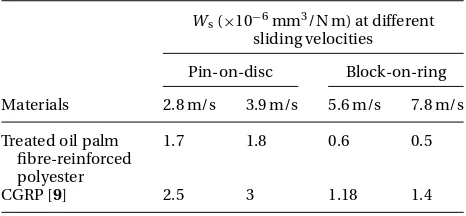Wet adhesive wear characteristics of untreated oil palm fibre-reinforced polyester and treated oil palm fibre-reinforced polyester composites using the pin-on-disc and block-on-ring techniques
Full text
Figure




Related documents
There were a total of 1,543 patients with twin pregnancies delivered in this study: 71 twin gestations were excluded due to gestational age < 28 weeks at delivery,
National Conference on Technical Vocational Education, Training and Skills Development: A Roadmap for Empowerment (Dec. 2008): Ministry of Human Resource Development, Department
In summary, we have presented an infant with jaundice complicating plorie stenosis. The jaundice reflected a marked increase in indirect- reacting bilirubin in the serum. However,
There are infinitely many principles of justice (conclusion). 24 “These, Socrates, said Parmenides, are a few, and only a few of the difficulties in which we are involved if
The earliest multicolor series notes to be released into circulation were the twenty and fifty francs notes, first paid out by the Banque de l’Algérie in 1918.. The last
“The AP test has not yet been generally used in the Joint Enterprise campaigns but,. elsewhere, the results of tests on 23,000 children have shown that it is as effective as Mantoux
(37) also in effect argue for a phylogenetically based, unitary application of the name Fu- sarium, but they focus on a single clade nested within the terminal Fusarium clade where
/ L, and a different adsorbent mass, is shown in Figure 5. The results obtained show that the removal rate increases quickly at first, until a time of 60 min, and

